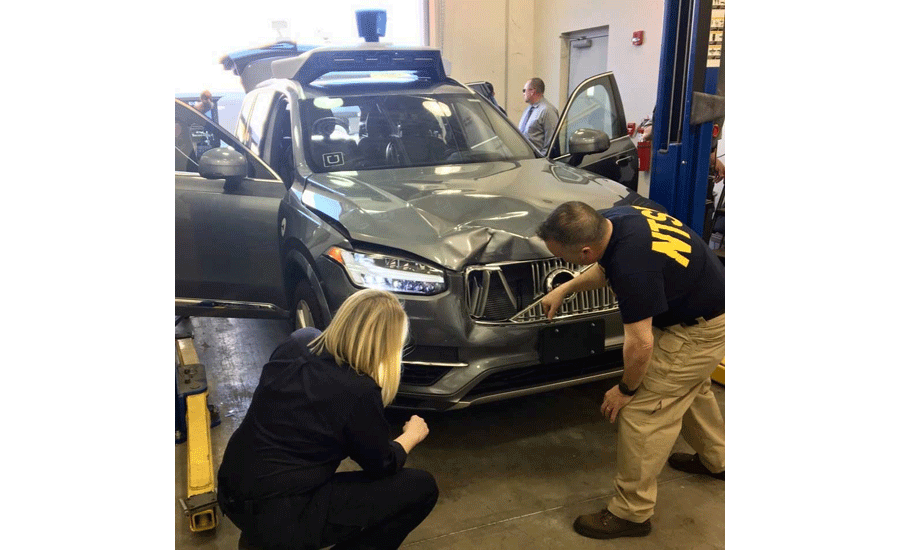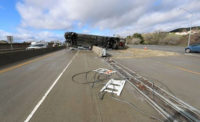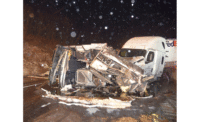NTSB report on deadly automated vehicle crash slams Uber for safety lack

There was plenty of blame to go around in the report released yesterday by the National Transportation Safety Board (NTSB) into its investigation of an automated test vehicle crash last year, but most of it was assigned to Uber, the company conducting the test.
Shown above: NTSB investigators on-scene in Tempe, Arizona, examining the Uber automated test vehicle involved in the collision. (NTSB photo)
Automatic brakes were deactivated
A pedestrian was killed in the March 18 collision in Tempe, Arizona involving an Uber Advanced Technologies Group (ATG) vehicle - a 2017 Volvo XC90, modified with a proprietary developmental automated driving system. The vehicle’s factory-installed forward collision warning and automatic emergency braking systems were deactivated during the operation of the automated system.
An Uber ATG operator was in the driver’s seat, but the automated system was controlling the vehicle when it struck the pedestrian at 39 mph.
Distraction played a role; at the time of the crash, the vehicle operator, Rafaela Vasquez, was found to have been watching NBC’s “The Voice” on her cell phone – although Vasquez denied using her cell phone during her interview with NTSB investigators. Also contributing to the tragedy: the pedestrian’s impairment at the time of the crash, coupled with her crossing outside a crosswalk at night. Additionally, the Arizona Department of Transportation exercised insufficient oversight of automated vehicle testing, the NTSB found.
But it was Uber Technologies Inc. division’s “inadequate safety culture” that was identified as the major culprit in the fatality.
"The last link of a long chain"
“Safety starts at the top,” said NTSB Chairman Robert L. Sumwalt. “The collision was the last link of a long chain of actions and decisions made by an organization that unfortunately did not make safety the top priority.”
The NTSB determined that the immediate cause of the collision was the failure of the Uber ATG operator to closely monitor the road and the operation of the automated driving system because the operator was visually distracted throughout the trip. Contributing to the crash was Uber ATG’s inadequate safety risk assessment procedures, ineffective oversight of the vehicle operators and a lack of adequate mechanisms for addressing operators’ automation complacency.
Among the investigation’s findings:
- The Uber ATG automated driving system detected the pedestrian 5.6 seconds before impact. Although the system continued to track the pedestrian until the crash, it never accurately identified the object crossing the road as a pedestrian -- or predicted its path.
- Had the vehicle operator been attentive, the operator would likely have had enough time to detect and react to the crossing pedestrian to avoid the crash or mitigate the impact.
- While Uber ATG managers had the ability to retroactively monitor the behavior of vehicle operators, they rarely did so. The company’s ineffective oversight was exacerbated by its decision to remove a second operator from the vehicle during testing of the automated driving system.
- Uber ATG made several changes to address the deficiencies identified, including implementation of a safety management system.
Before allowing test vehicles on public roads...
The NTSB is calling upon federal regulators to create a review process before allowing automated test vehicles to operate on public roads.
The NTSB issued a total of six recommendations to the National Highway Traffic Safety Administration, the state of Arizona, the American Association of Motor Vehicle Administrators and Uber ATG.
The NTSB recommended that NHTSA require entities wishing to test a developmental automated driving system on public roads to submit safety self-assessment plans before being allowed to begin or continue testing and that NHTSA should review the plans to ensure they include appropriate safeguards.
A link to the executive summary, findings, probable cause and recommendations is available online at https://go.usa.gov/xp9Eu . The full report is expected to be released within the next few weeks.
Looking for a reprint of this article?
From high-res PDFs to custom plaques, order your copy today!






